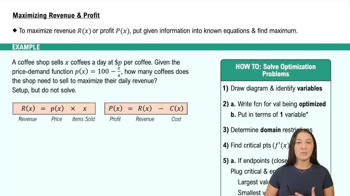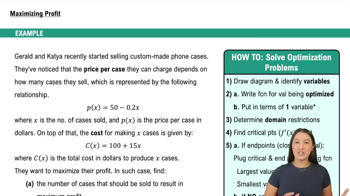Table of contents
- 0. Functions7h 52m
- Introduction to Functions16m
- Piecewise Functions10m
- Properties of Functions9m
- Common Functions1h 8m
- Transformations5m
- Combining Functions27m
- Exponent rules32m
- Exponential Functions28m
- Logarithmic Functions24m
- Properties of Logarithms34m
- Exponential & Logarithmic Equations35m
- Introduction to Trigonometric Functions38m
- Graphs of Trigonometric Functions44m
- Trigonometric Identities47m
- Inverse Trigonometric Functions48m
- 1. Limits and Continuity2h 2m
- 2. Intro to Derivatives1h 33m
- 3. Techniques of Differentiation3h 18m
- 4. Applications of Derivatives2h 38m
- 5. Graphical Applications of Derivatives6h 2m
- 6. Derivatives of Inverse, Exponential, & Logarithmic Functions2h 37m
- 7. Antiderivatives & Indefinite Integrals1h 26m
- 8. Definite Integrals4h 44m
- 9. Graphical Applications of Integrals2h 27m
- 10. Physics Applications of Integrals 2h 22m
5. Graphical Applications of Derivatives
Applied Optimization
Problem 59b
Textbook Question
Minimizing related functions Complete each of the following parts.
b. What value of x minimizes ƒ(x) = (x- a₁)² + (x - a₂)² + (x - a₃)² , for constants a₁, a₂, and a₃?
 Verified step by step guidance
Verified step by step guidance1
First, recognize that the function ƒ(x) = (x - a₁)² + (x - a₂)² + (x - a₃)² is a sum of squares, which is a quadratic function in terms of x.
To find the value of x that minimizes this function, we need to take the derivative of ƒ(x) with respect to x. The derivative will help us find the critical points where the function could have a minimum.
Calculate the derivative: ƒ'(x) = 2(x - a₁) + 2(x - a₂) + 2(x - a₃). This simplifies to ƒ'(x) = 6x - 2(a₁ + a₂ + a₃).
Set the derivative ƒ'(x) equal to zero to find the critical points: 6x - 2(a₁ + a₂ + a₃) = 0.
Solve for x: x = (a₁ + a₂ + a₃) / 3. This value of x minimizes the function ƒ(x) because it is the point where the derivative is zero, indicating a potential minimum.
 Verified video answer for a similar problem:
Verified video answer for a similar problem:This video solution was recommended by our tutors as helpful for the problem above
Video duration:
3mPlay a video:
Was this helpful?
Key Concepts
Here are the essential concepts you must grasp in order to answer the question correctly.
Quadratic Functions
Quadratic functions are polynomial functions of degree two, typically expressed in the form f(x) = ax² + bx + c. They graph as parabolas, which can open upwards or downwards depending on the sign of the coefficient 'a'. The vertex of the parabola represents the minimum or maximum point of the function, which is crucial for optimization problems.
Recommended video:
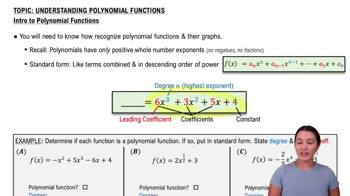
Introduction to Polynomial Functions
Minimization
Minimization in calculus involves finding the lowest point of a function, which can be achieved using techniques such as taking the derivative and setting it to zero to find critical points. The second derivative test can then confirm whether these points are minima or maxima. In the context of the given function, we seek the value of x that minimizes the sum of squared differences.
Recommended video:
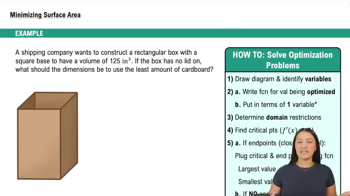
Example 1: Minimizing Surface Area
Completing the Square
Completing the square is a method used to transform a quadratic equation into a perfect square trinomial, making it easier to analyze its properties. This technique is particularly useful for finding the vertex of a parabola, which directly relates to identifying the minimum value of a quadratic function. In the context of the problem, it can help simplify the expression to find the optimal x value.
Recommended video:
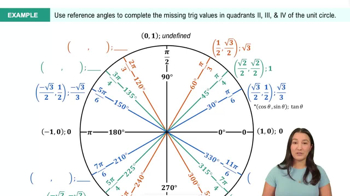
Trig Values in Quadrants II, III, & IV Example 1

 1:13m
1:13mWatch next
Master Intro to Applied Optimization: Maximizing Area with a bite sized video explanation from Callie
Start learningRelated Videos
Related Practice



